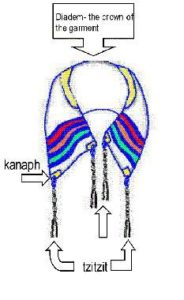
Tallit (Prayer Shawl)
with Tzitzit (Fringes)
The tallit or Jewish prayer shawl was commanded by God as a garment to remind the Jews that their salvation lay in prayer to Him rather than by works of the Law (Nu 15:37-40). I draw a direct connection between the Jews and prayer in their victory over the Amalekites (Ex 17:8-16).
The Jews were to live by prayer; however, the Old Testament details their failure to live by faith and prayer even though frequently reminded of their failure through the words of the prophets. The Jews chose instead to live by the works of the Law. However, this does not render impotent God’s words and imagery given to His people and passed down to the Christians today. The problem is that the Gentile churches have read their meanings into the Word rather than read God’s meaning from the Word. The imagery of wings or hem of the garment is such a case in point.
This garment was frequently worn as a “shirt” under the robe as it is today by several Jewish sects. Or, it could be worn as a shawl over the robe and used to cover the head during prayer thus, providing a “private” corner in which to pray to God, something that would have been missing in most Jewish homes in the Old Testament since these were usually one room homes with access to the roof. The “Servant of the Messiah” site has an excellent article on how to understand the Tallit and associated references in Scripture.
When churches became primarily Gentile and rejected the Jewish culture, because they killed Jesus, they severed their understanding of the Bible. The Old Testament is a Jewish book and must be understood within a Jewish context. The New Testament was written primarily by Jews from an Old Testament Jewish perspective (which is why Jesus spent three years with His apostles, to correct their misperceptions about the Bible as practiced by both the Sadducees and Pharisees). When believers did not understand the Jewish references they supplied their own understanding and these because codified in tradition. It has only been in the past 200 years or so that any serious effort has been made to understand the Scriptures in their Jewish context.
Having said this I do not imply that Christians need to practice Judaism in order to have a “purer” faith. That is not implied in the First Church Council (Ac 15:19-21). However, it is essential to understand the Jewish references and context in order to understand what God was saying through the Jewish writers. This is called normative hermeneutics (mislabeled as literal interpretation in previous generations).
The tallit would have been a familiar article of clothing to everyone Jewish person and its references in Scripture would have been clearly identified. For example, when Saul tore Samuel’s garment as Samuel turned to go, Saul tore a tzitzit from Samuel’s tallit. It was this blatant disrespect of God and prayer to God for strength that caused Saul disobedience. He desired the praise of men (politician) rather than the praise of God who had given him the throne (1Sa 15:26-28). The Gentile view that Saul tore Samuel’s robe only shows disrespect toward Samuel while tearing off a symbol of the Law from the garment that represented a prayerful attitude toward God disrespected His Lord directly. It was for this that Saul lost the kingdom. Without prayer it was impossible for him to resist the lure of man’s praise and without faith one cannot believe that prayer works. He proved he was unfit to be God’s representative among the people. This failure of government to be faithful to God follows the priesthood’s failure to be faithful to God which gave rise to the prophets, an independent voice calling the people to be faithful to their faithful God.
When Malachi speaks of God rising with healing in His wings he is not speaking about birds, which usually have a negative connotation in Scripture (Mal 4:2). The imagery actually given is that Christ will rise with healing in His tallit for His people who follow Him in faith as evidenced by their prayers to Him. This corrected view destroys the Gentile paintings and graphics of an eagle overshadowing people with his wings (a jingoistic Americanism at best). Christ prays for His people and these prayers cover His people on earth.
The gospel account of the woman healed from bleeding (menstrual bleeding which made her unclean and thus unable to participate in Jewish society) is another example of the tallit (Mt 9:20-21). She had only to touch a tzitzit of His tallit to be made “whole”, clean, with the healing of her uncontrollable menstrual bleeding. She could rejoin her family, her synagogue. Her faith saved her soul as evidenced by her physical healing. Her turning from worthless works to faith in Christ for salvation made her whole both physically and spiritually. (This is not a modern application for faith healing which is a Gnostic practice.)
What is being promoted in each of these examples and throughout the Bible is the dependence on prayer both for the believer to Jesus and Jesus for the believer. This is consistent throughout the Bible. While we do not routinely use tallits nor have tzitzits on our garments, this does not negate the absolute reliance the Christian must have on prayer. Yet, for many Christians prayer seems like an option, something to do in extreme stress or trouble but not needed for everyday life. This lack of understanding of prayer is catastrophic to churches today, just as it was for the Jews in the Old Testament.
The imagery of the tallit more clearly emphasizes the essential aspect of prayer in a pictorial fashion that can be understood across the generations and cultures. We do not need to wear the tallit to practice consistent prayer (1Th 5:17). However, we do need to practice consistent prayer or else find ourselves rejected just as Saul was rejected for without reliance on God in prayer we find ourselves reliant on men in works and this is the predicament of many churches today.
